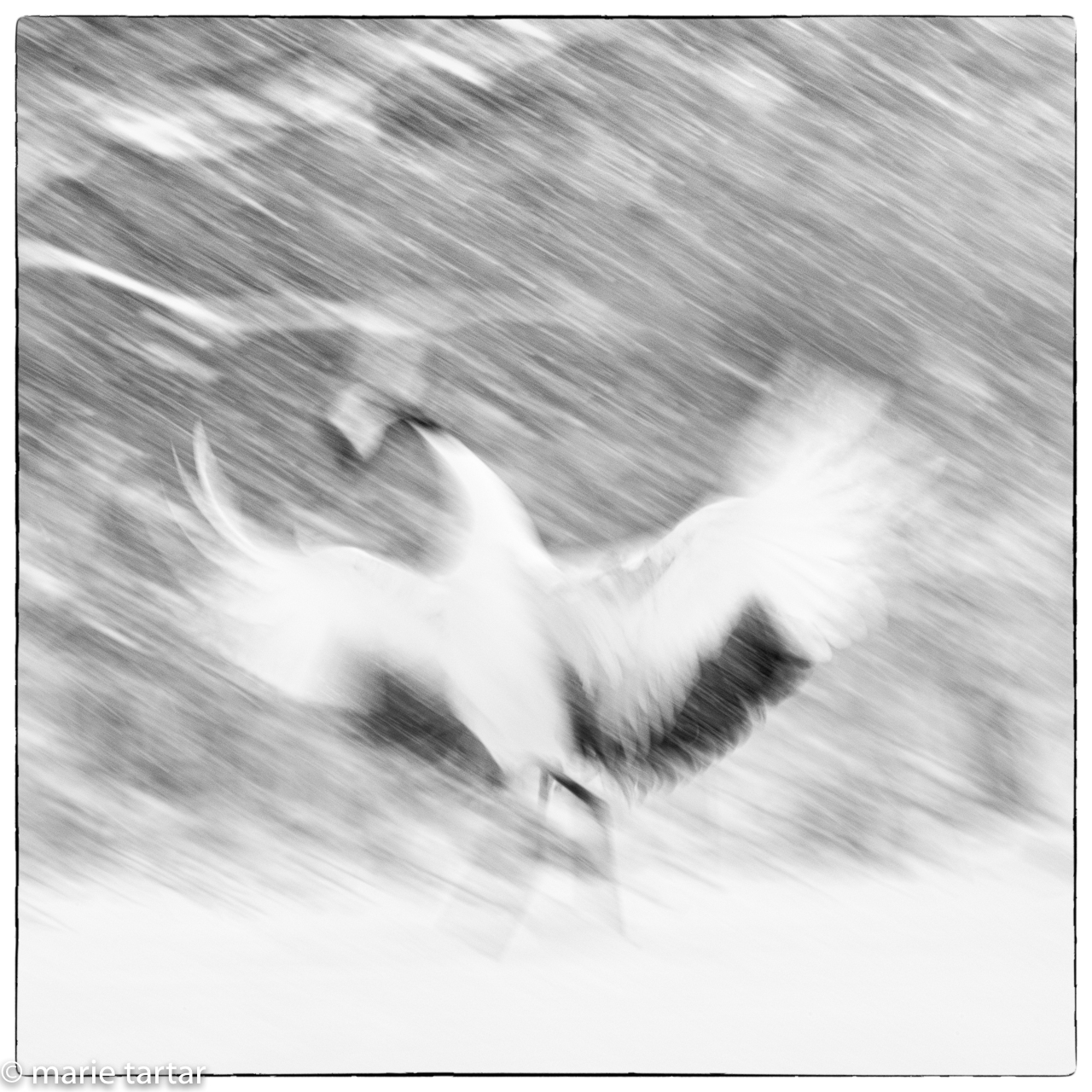
Our accommodation for this evening was Green Park Hotel in Tsurui. Tsurui means “cranes are here”.
Sunday, February 4, 2018
5:45 am: Glancing out the hotel entrance, driving snow in lines outlined the van under the hotel’s portico. Our focus for this day was the red-craned crane (Grus japonensis), a potent symbol in Asian cultures for longevity and fidelity. These large cranes are famed for their courtship rituals, a “dance” in which pairs throw their heads back and duet. They are a frequently employed motif in textiles, represented in origami at temples throughout Japan, even the symbol of Japan Airlines.
They are an ecological success story, brought back from the edge of extinction. As recounted by naturalist Mark Brazil, as a food source, they were once reserved for emperors. Once feudal restrictions were lifted, they were hunted to near extinction, with a small population surviving in Hokkaido’s marshes. Encroachment on their breeding grounds by agricultural expansion brought the birds to an estimated low in the Kushiro marshes of only 20 birds in 1924! A turning point was National Monument designation in 1935. Supportive measures by the local residents began in the 1950s, helping to stabilize the population through the winter with a reliable food supply. By the late 1980s, the local population reached 400 for the first time in a century. The current estimate for the resident Hokkaido population is approximately 1500, or about half the world population.

Japanese cranes are also known as tancho or Manchurian cranes or red-crowned cranes. They are one of the largest crane species and rare, with half of the world’s population resident in Hokkaido, where they are protected.
Otowa-bashi, a pedestrian bridge, was lined with tripods and photographers, even though it was still dark. Susan estimated by binoculars 200 cranes in the distance beyond a sinuous curve in the river.
The river doesn’t freeze in winter, so the birds can forage for fish. Photographically, it was tough, trying to make fine finger adjustments wearing thick gloves, while wrestling with a clear baggie-like covering, trying to keep the insistent snow at bay and my own hood from encroaching on my vision.

Challenging shooting in snow, not just standing in snow, but actively falling (Japan, Tsurui, Hokkaido)
Heading back to the hotel for breakfast and to warm up, I made a fateful mistake, a classic case of no good deed going unpunished. Trying to be helpful, I slipped on icy snow after closing the back of the vehicle, falling in a funny position, punctuated by a distinct pop from my left lateral ankle. Sprained! This was to slow me down to hobbling for the remainder of the trip, limping. I was able to bear weight, so was pretty sure I hadn’t fractured a bone, but was suddenly unable to pivot or walk normally. Taking my boot off later at the hotel, there wasn’t much swelling initially, but it had been effectively splinted by my padded snow boot. Only 2 days later could I see distinct purple bruising, in a thick broad brushstroke below my lateral malleolus, with fainter green above and behind the malleolus.
After breakfast, we headed back out. It was snowing heavily still. Round two was Itoh Crane Sanctuary, a field where the snow cranes congregate and food is put out for them. It too was filled with vehicles and photographers with tripods. Susan had rushed us through breakfast, emphasizing we would have trouble establishing a prime shooting position at the fence if we arrived after 9 am. This time I was better equipped against cold feet, having slipped in a pair of hotfeet warmer insoles when I took my boots off to examine my ankle. I also had dug out my Aquatech wet weather camera cover, which was still awkward, but an improvement over the counterproductive plastic bag.
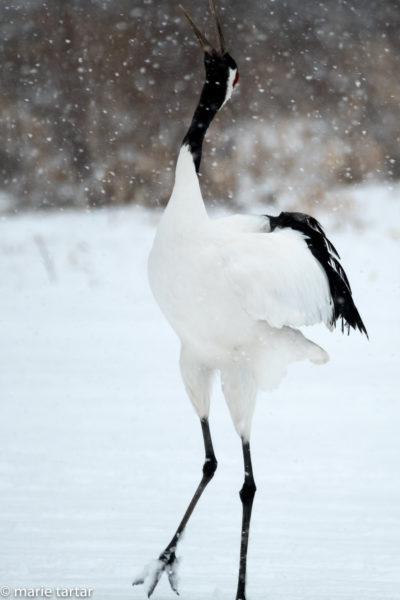
It’s hard not to read joy into this head thrown back, duet singing posture of the red-crowned crane of Hokkaido
In the afternoon, we transferred to our next lodging, taking in the Notsuke peninsula along the way. There was driving wind and snow. A deer buck with an impressive rack was feeding near the road, close enough to get a good shot from the van with the door slid open. Unfortunately, my camera bag was at the bottom of the stack in the back and couldn’t be easily dug out.
Further on, we tried to use the vehicle as a wind brake, to shoot distant skaggy trees in an icy landscape. I couldn’t really hobble fast enough to reach where I really wanted to shoot.
Arriving at our destination, Rausa, our accommodation was an imported Canadian log cabin, Rausa Kuru. Delayed by my ankle ascending the stairs to the second floor, all of the rooms but one Japanese style room were already claimed. Swinging open the door, my heart sank, seeing futons folded on the floor, which now seemed much further away than it had when I awoke that morning.
Ordinarily, I prefer a Japanese to a western style room, but with my ankle the way it was, the prospect of pushing myself up off a floor-height futon was too much.
With Jack’s intervention, Susan was strong-armed into swapping rooms with us. This proved to be a typical interaction. As a leader, she was competent in many ways, speaking Japanese fluently and ably piloting a vehicle on the opposite side of the road through thick snow. But in care and concern for guest welfare, she left a lot to be desired.
My new slowed-down reality was settling in. It was taking me longer to get in and out of the van, into the hotel and into shooting position, even getting dressed was taking much longer. This day’s shooting hadn’t been significantly impacted. But the following day, the plan was to go on a boat excursion to shoot sea eagles. With my ankle now less capable of reacting to sudden shifts in position, I could only hope it wouldn’t be too rocky on the boat…little did I know, my ankle injury, while inconvenient, was not to be the most troubling issue to plague me on this trip.
-Marie
P.S. (Sunday, February 14, 2021) While looking for maps of Yosemite for an upcoming winter photography trip (and chase of the elusive firefall phenomenon), I came across newspaper clippings saved from years back of destinations I hoped to make. One yellowed clip was from the Los Angeles Times, dated March 14, 1999 (22 years ago!) and was about winter birding in Hokkaido and specifically about these very cranes!

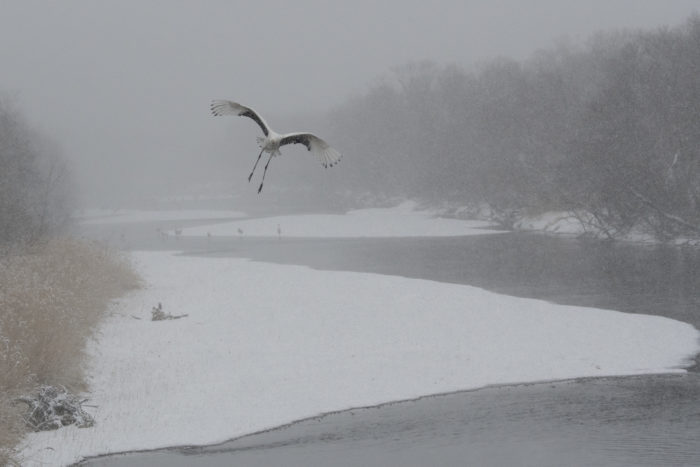
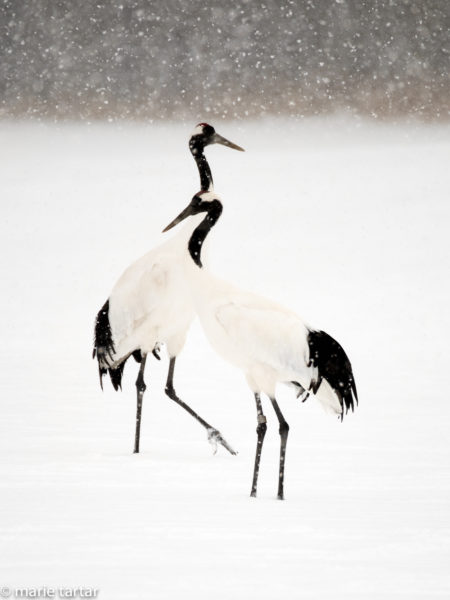

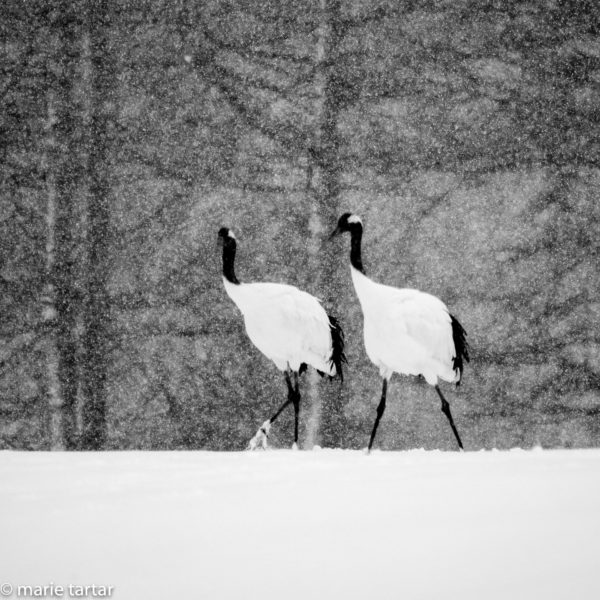
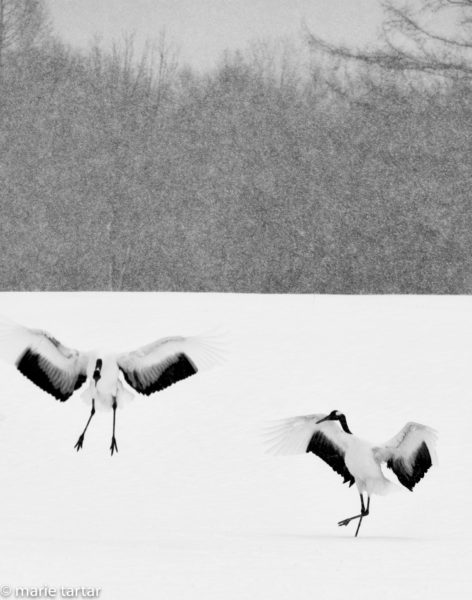
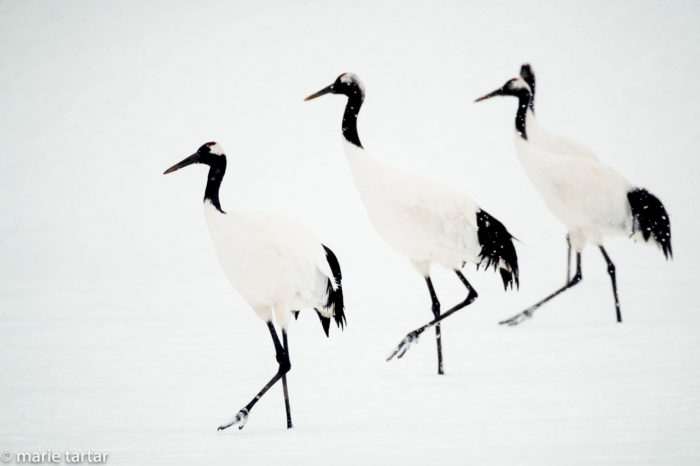


Your photography is breathtakingly beautiful & mesmerizing along with your story. I feel like I’m reading a series waiting after each read for the next installment!
Stay tuned, Steph, It gets worse, much worse!
-Marie
Your photos are truly stunning.
Thank you, Christina, stay tuned for more beautiful birds in upcoming posts!
-Marie
Very nice Marie. Now I need to go back to Japan in the winter. Great subjects for black and white!